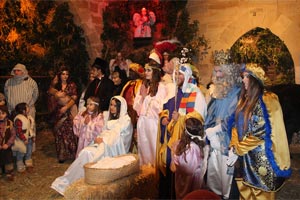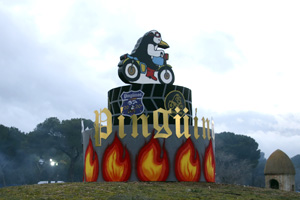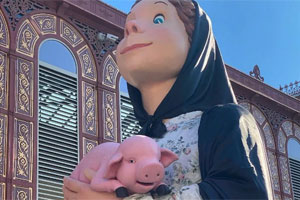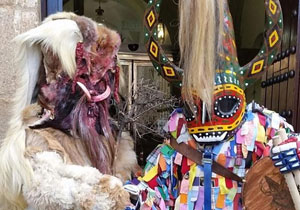Holly Week in Viveiro
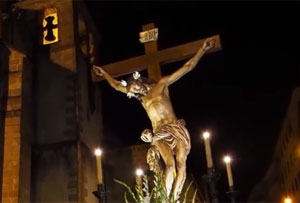
Why visit the Holy Week of Viveiro
The Holy Week of Viveiro is one of the most important celebrations in the city of Viveiro, located in the province of Lugo, in Galicia. During this week, processions and liturgical acts are held that commemorate the passion, death, and resurrection of Jesus Christ.
In 2013, it received the recognition of International Tourist Interest. It stands out for its great artistic value of imagery and goldsmithing and for having a sober and austere character, similar to the Castilian Holy Week. The main events begin on Good Friday and last more than a week, in which eight Brotherhoods and Fraternities coordinated by the Board of Brotherhoods participate, organizing different processions that represent the Passion of Christ.
One of the most anticipated processions is that of Maundy Thursday, in which the Last Supper and the washing of feet are represented. In this procession, participants are dressed in white robes and carry a lit candle. Another important procession is that of Good Friday, in which the way of the cross of Jesus Christ is represented.
In addition to the processions, other activities are also carried out during the Holy Week of Viveiro, such as concerts of sacred music, exhibitions, and theatrical performances.
The Holy Week of Viveiro is very popular among the inhabitants of the city and also attracts many tourists who want to experience this religious celebration so deeply rooted in Galician culture.
Origin and History
The Holy Week of Viveiro has its origins in the Middle Ages, although its current structure was consolidated throughout the seventeenth and eighteenth centuries. During this period, brotherhoods and fraternities were established that still participate in processions and liturgical acts today.
One of the most significant moments of the Holy Week of Viveiro is the procession of Maundy Thursday, which represents the Last Supper and the washing of feet. This procession originated in the eighteenth century when the Brotherhood of the Most Holy Sacrament was founded, which aimed to worship and care for the Most Holy Sacrament.
The Holy Week of Viveiro has had ups and downs throughout its history, and at some points, it disappeared, as happened during the Spanish Civil War. However, in the 1950s, it was recovered and reorganized, thanks to the initiative of some people and entities in the city.
Today, the Holy Week of Viveiro is one of the most important religious celebrations in the city and actively involves the different brotherhoods and fraternities. Additionally, it attracts many tourists who want to get to know the tradition and culture of Galicia up close.
What to see in Viveiro
Viveiro is a city in the province of Lugo, and it has a great wealth of cultural, natural and heritage attractions. Among the main tourist attractions offered by the city are the following:
- Historic center: The historic center of Viveiro is one of the oldest and best preserved in Galicia, and it is declared a historical-artistic complex. It is possible to visit monuments such as the church of Santa María, the convent of San Francisco, the Palace of the Counts of Maceda, among others.
- Beaches: Viveiro has a coastline full of beaches and coves, some of the most famous being Covas, Area, Sacido, and Abrela beach.
- Castro de Ouro: The Castro de Ouro is a castro settlement located on a hill that dominates the city of Viveiro, where the remains of the ancient fortification can be seen.
- Mount Faro: From Mount Faro, which is about 15 minutes by car from the city center, you can enjoy spectacular panoramic views of the Viveiro estuary and the city.
- Festivals: Viveiro is known for its festivals, such as Holy Week, the San Juan festival, the festivals of the Virgen del Carmen, and the Medieval Fair.
- Gastronomy: Galician cuisine is well-known worldwide, and in Viveiro you can taste typical dishes such as pulpo a feira (fair-style octopus), empanada gallega (Galician pie), lacón con grelos (boiled pork shoulder with turnip greens), among others.
Marina: Viveiro has a marina, the Covas marina, where water sports can be practiced and the beauty of the sea can be enjoyed.
But these are just some of the many tourist attractions that the city of Viveiro offers.
Typical popular cuisine
Galician cuisine in general is very rich and varied, and Viveiro is no exception. Some of the typical and popular dishes of the city and its surroundings are:
- Pulpo a feira: Pulpo a feira is one of the most emblematic dishes of Galician cuisine, and consists of boiled octopus in water with salt, and accompanied by paprika, olive oil and coarse salt.
- Empanada gallega: Empanada gallega is a kind of pie filled with tuna, scallops, clams, meat, or any other desired ingredient. It can be eaten hot or cold.
- Lacón con grelos: Lacón con grelos is a typical dish of Galician cuisine that consists of a piece of boiled pork shoulder with turnip greens, potatoes, and chorizo.
- Zorza: Zorza is a typical Galician sausage, which is made with pork meat marinated with garlic and paprika, and is usually used to make empanadas or to accompany other dishes.
- Galician broth: Galician broth is a soup made with potatoes, turnip greens, white beans, chorizo and pork shoulder.
- Scallops: Scallops are one of the most popular seafood in Galicia, and can be found in many restaurants in the area, either grilled, in sauce or gratin.
- San Simón cheese: San Simón cheese is a smoked cheese made with cow's milk in the San Simón area, in the province of Lugo.
These are just some of the many typical and popular dishes that can be found in Viveiro and Galician cuisine in general.

